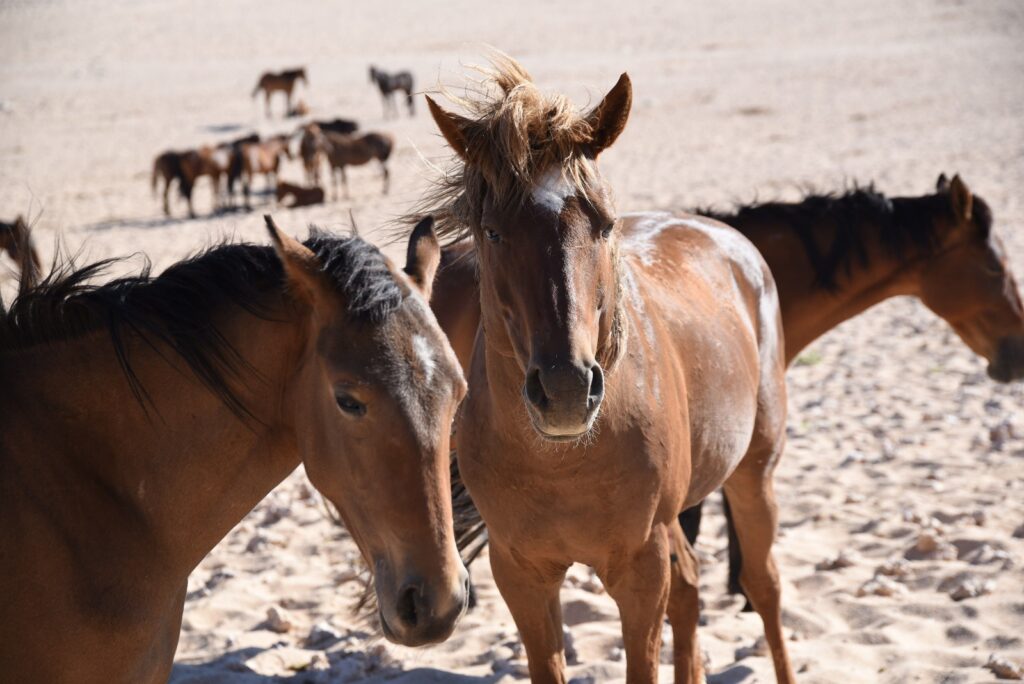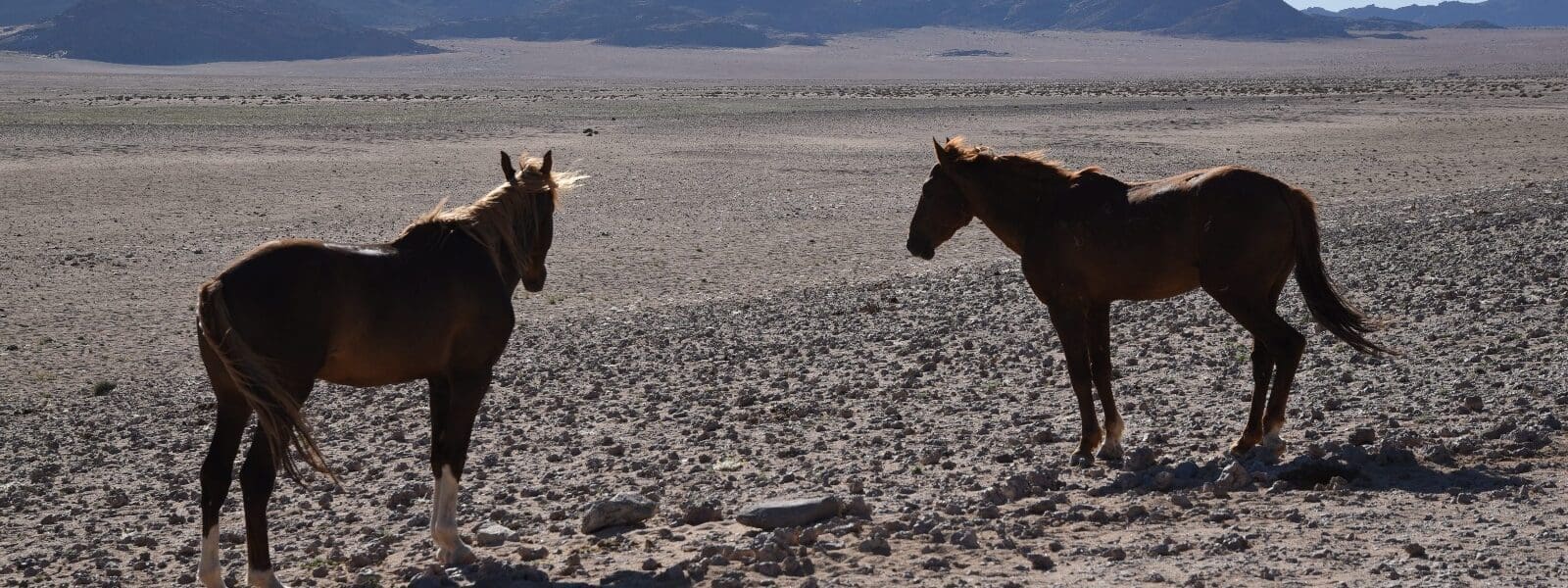The Namibia Wild Horses: Guardians of the Namib Desert
In Namibia’s vast, unspoiled landscapes, where endless desert horizons blend with golden sands, a unique wonder captivates travelers and locals alike: the Namibia Wild Horses. These majestic creatures embody resilience and mystery, representing the spirit of a rugged and remote land where survival is an art form. This article delves into the origins, history, survival adaptations, conservation efforts, and opportunities for witnessing the wild horses of Namibia.
Origins and Mystery of Namibia’s Wild Horses
The origins of Namibia’s wild horses remain an enigma, with theories tracing their lineage back to various points in history. One prominent theory suggests that these horses are the descendants of animals abandoned by German colonial troops during World War I, while another speculates they descended from horses brought by settlers that escaped or were abandoned. Over the years, the horses adapted to the harsh environment of the Namib Desert, transforming from domesticated animals into resilient wild horses that are fully integrated into Namibia’s unforgiving landscape.
Whether or not the true origin of these horses is ever fully confirmed, they have come to symbolize resilience. Their presence in Namibia is not just a tale of survival but a story that captures the interest of researchers, conservationists, and nature lovers. These wild horses are now an inseparable part of Namibia’s desert ecology, and the ongoing interest in their origin is just one chapter in their remarkable journey.
The Iconic Desert Residents
The Namibia Wild Horses are emblematic of the Namib Desert, their dark silhouettes frequently spotted against towering dunes and barren landscapes. Unlike other horses that rely on more temperate environments, these wild horses have adapted to the desert’s harsh and often unpredictable climate. Temperatures can soar during the day and drop drastically at night, and water is sparse. To survive, the horses have developed unique behaviors, such as digging in dry riverbeds to access groundwater and grazing on the minimal vegetation that dots the desert.
Over decades, their remarkable resilience has become the stuff of legends. The Namibia Wild Horses have captured the imagination of those who come to witness their raw beauty, seemingly out of place yet deeply connected to the land. They embody survival and adaptation in one of the world’s harshest climates, and their presence in Namibia is not only beautiful but inspiring.

Threats to Survival
While the Namibia Wild Horses have made a life for themselves in the Namib Desert, they face a range of challenges threatening their continued survival. Encroachment from human settlements has reduced their available habitat, limiting their range and resources. Competition for scarce water sources and vegetation is also an issue, as other native species like gemsbok and zebra rely on the same resources.
Additionally, the small population size brings its own set of concerns. Limited genetic diversity increases the risk of inbreeding, which can lead to genetic defects and make the population more vulnerable to diseases. To mitigate this risk, conservation efforts are critical. Further, predation poses another challenge, particularly from large carnivores like hyenas, which may prey on foals. Together, these threats create a precarious balance, making the survival of Namibia’s wild horses a delicate issue.
Conservation Efforts and Initiatives
Recognizing the importance of preserving these unique animals, various organizations and local communities have initiated conservation efforts aimed at protecting the Namibia Wild Horses. These efforts include managing population numbers, monitoring health, and implementing sustainable strategies to reduce human-wildlife conflict.
Conservation groups and government bodies work together to create buffer zones around critical habitats, ensuring that both wild horses and local communities can thrive. Monitoring efforts also help track the horses’ well-being and population dynamics, enabling conservationists to make informed decisions on management strategies. Importantly, these efforts include educating the public about the ecological significance of the Namibia Wild Horses and the essential role that responsible tourism plays in their preservation.
Moreover, local conservation groups emphasize the importance of avoiding direct interaction with the horses, as human interference can lead to stress and behavioral changes in these animals. By fostering respect for the wild horses’ independence, conservationists strive to maintain the animals’ natural behaviors, thereby supporting their survival and well-being.
Responsible Tourism and Viewing Opportunities
For those captivated by Namibia’s wild beauty, the Namibia Wild Horses offer a compelling reason to visit the Namib Desert. Organized tours allow visitors to see these extraordinary animals in their natural habitat, offering a rare glimpse into the lives of horses that have returned to a feral state. Tours are often led by guides who share insights into the horses’ unique adaptations and the ongoing conservation efforts, underscoring the significance of respectful and responsible tourism.
Responsible tourism practices include maintaining a safe distance, refraining from feeding or attempting to interact with the animals, and adhering to designated viewing areas. By promoting ethical tourism, tour operators contribute to the horses’ protection while ensuring that visitors experience the authentic beauty of Namibia’s natural landscapes. The Namibia Wild Horses have become an invaluable part of the region’s ecotourism, attracting those who seek a deeper connection with the untamed beauty of the desert.
The Legacy of Namibia’s Wild Horses
The Namibia Wild Horses are more than just animals surviving in a harsh environment; they are icons of resilience and adaptability. As they continue to roam the vast stretches of the Namib Desert, these horses leave a lasting impact on the landscape and in the hearts of those who see them. Their presence in Namibia reminds us of the power of nature and the importance of protecting unique wildlife populations from the many threats they face.
As Namibia’s wild horses embody the indomitable spirit of the desert, they also represent a broader commitment to conservation and the responsible stewardship of natural resources. Preserving this population ensures that future generations can witness the awe-inspiring sight of wild horses thriving against the odds in one of the world’s most remarkable landscapes.
In conclusion, the Namibia Wild Horses are not only a symbol of the Namib Desert’s raw beauty but also a testament to the resilience of life. Their story is one of adaptation, survival, and ongoing conservation efforts that strive to keep their legacy alive. The future of these horses relies on a collective effort from conservationists, locals, and visitors alike to protect and preserve their existence. In protecting the Namibia Wild Horses, we also protect a piece of Namibia’s natural heritage, ensuring that their wild spirit continues to inspire generations to come.
Curious to see the Namibia Wild Horses? Contact Us for more details or explore our 12 Day Namibia Southern Classic Safari!
Where can I see the Namibia Wild Horses?
The best place to see the Namibia Wild Horses is in the Namib Desert, particularly around the Garub area near Aus in southern Namibia. These horses often roam freely in this region, and there are designated viewpoints where visitors can observe them without disturbing their natural behavior.
What is the best time of year to visit the Namibia Wild Horses?
You can see the Namibia Wild Horses year-round, but the cooler months from May to September offer a more comfortable experience for visitors. During the dry season, the horses often gather near water sources, making them easier to spot.
What should I avoid doing when visiting the Namibia Wild Horses?
When visiting the wild horses, avoid getting too close or attempting to touch or feed them. Human interaction can disrupt their natural behaviors and diet, potentially harming their health. Also, never litter or leave food scraps behind, as it can attract predators to the area.
What are some recommended do’s for observing the Namibia Wild Horses?
When visiting, keep a respectful distance and use binoculars or cameras with zoom lenses to observe them closely. Follow any guidelines set by local tour operators or park officials to minimize environmental impact. Most importantly, enjoy the experience quietly and be mindful of leaving no trace of your visit.


You must be logged in to post a comment.